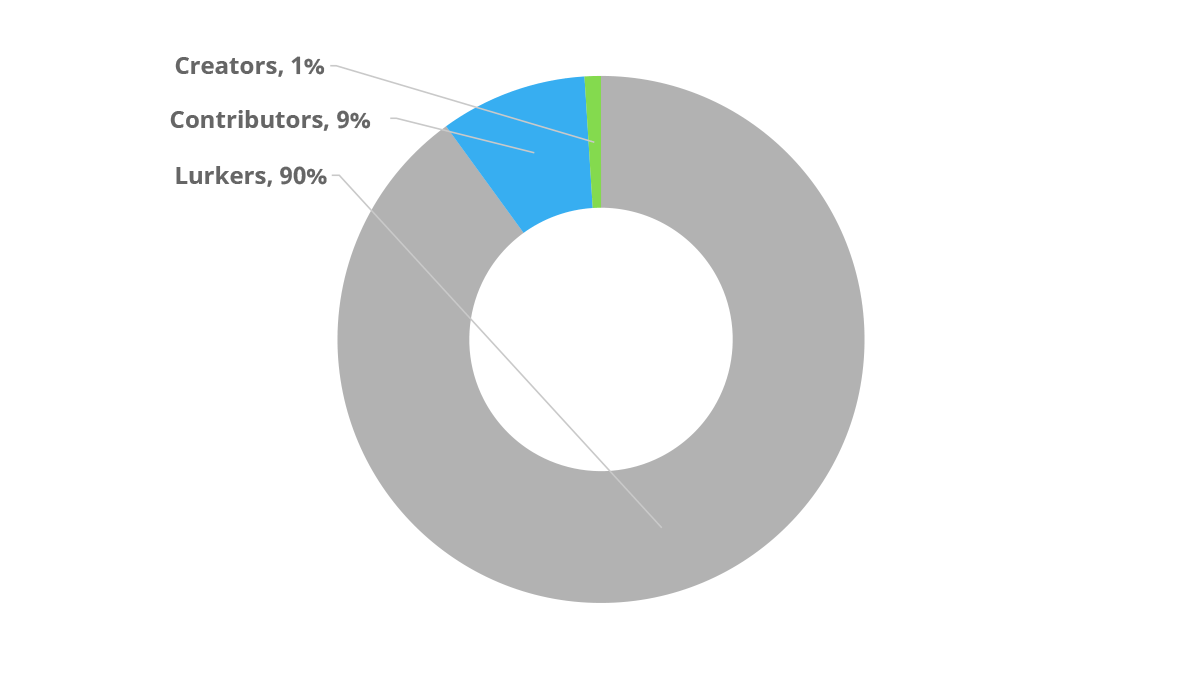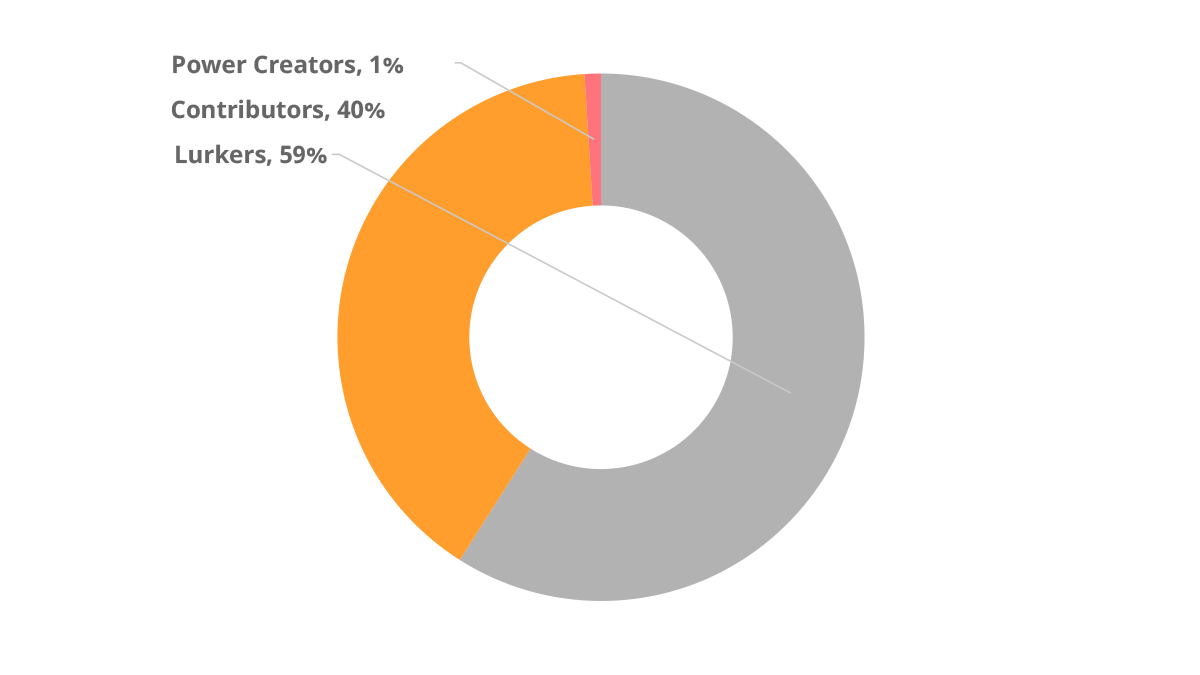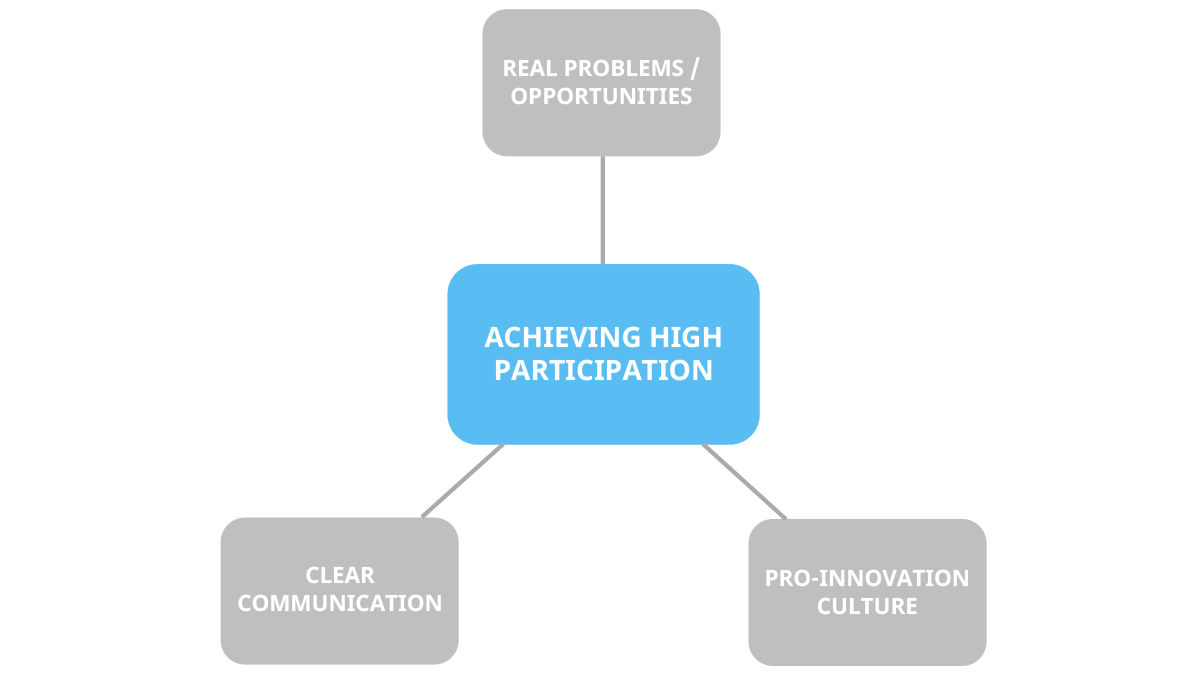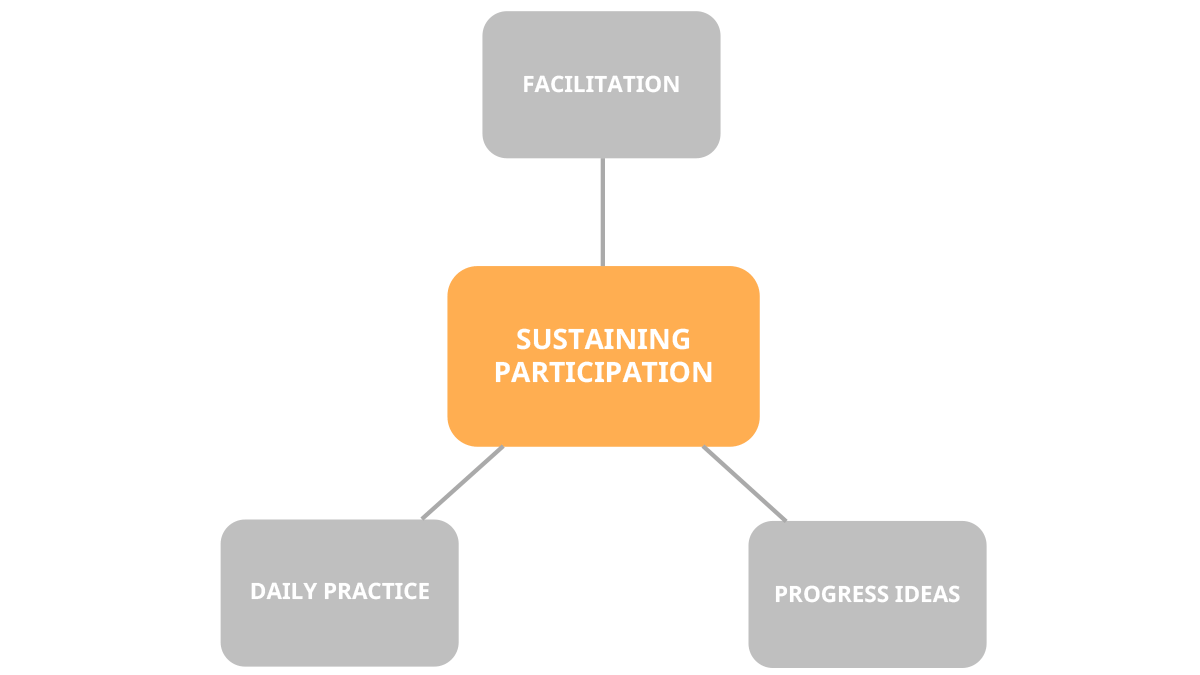Achieving and sustaining high participation rates in ideation
Whenever we start working with a new customer, some of the first questions we tend to hear are usually related to participation rates:
- “What is a good participation rate for ideation?”
- “How do we achieve a good participation rate in our ideation activities?”
- “How do we sustain that high rate of ideation over time?”
These are great questions for being able to benchmark your performance and to see if there’s still room for improvement. These questions are also interesting in the sense that you can look at them from a number of different perspectives.
We’ll address each of these questions below to provide you with a solid overview on the topic, as well as actionable tips for achieving and maintaining a high participation rate in your ideation work.
Table of Contents

What is a good participation rate in ideation?
The short answer is that it depends on your target audience, as well as your goals for the ideation activities.
If you’re engaging a large audience of people who aren’t very familiar with each other, and you’re asking them for ideas on a highly complicated topic, your participation rate will inevitably be pretty low.
If, on the other hand, you’re asking for simple, incremental improvement ideas from a small audience that already knows each other well, your participation rates could easily be ten times higher.
Let’s next look at some concrete numbers to illustrate this.
It’s been shown that on the internet, and social networks and communities in general, 90% of people are passive observers, 9% of people contribute occasionally and 1% of users are heavy content creators.
 These numbers are usually a solid starting point for a case where your audience resembles the internet: a large audience of people who aren’t familiar with each other and don’t know who else is watching.
These numbers are usually a solid starting point for a case where your audience resembles the internet: a large audience of people who aren’t familiar with each other and don’t know who else is watching.
On the other end of the spectrum, small teams and organizations typically see virtually everyone participate in the ideation work, which is the case for example in our company.
The most common situation, at least among our customers, are audiences of a few hundred to some thousands of people within the same organization.
In these cases, the employees know many, if not most, of the other employees personally and know who the other participants are by background as well, which makes it psychologically easier to participate.
We’re typically seeing 25-40% of employees contributing to the discussion with our larger customers. Others in the industry, have reported similar but slightly lower figures.
 So, as long as you’re within that range, you can consider your ideation to be quite active.
So, as long as you’re within that range, you can consider your ideation to be quite active.
In that case, there’s no need to worry about increasing participation further. You can instead simply sustain the current level and focus more on some of the other aspects of idea management.
After all, the point of ideation activities shouldn’t be to get as many people to participate as possible, but to get as many quality ideas as possible.
However, if your participation rates are below 25%, there’s likely to be plenty of room for improvement.
If that is the case, you might want to look into some of the practices we’ve listed below for getting those rates up.
Achieving a high participation rate
Sustainably active participation in ideation work isn’t hard but it’s also not something that you can achieve by just using a few quick tricks. In essence, you have to get the fundamentals right.
Let’s look into the some of the common themes that we’ve seen across our most successful customers.

1. Solve real problems or tackle interesting opportunities
As 84% of executives consider innovation to be very important for the future success of their organizations, there’s often plenty of pressure on the organization to innovate.
This pressure, unfortunately, can lead to an organization running around doing one activity after the other with little or no evidence of a cohesive innovation strategy. Accelerators, innovation labs, idea challenges, you name it and these organizations have likely tried it.
While this can sometimes initiate a lot of buzz at first, soon people will realize that there’s little real progress being made, at which point they typically lose interest and participation rates will drop.
So, the first and most important thing to get the right is to have a clear plan on how the ideation is linked to the organization’s strategic goals and to make sure that the point of the ideation activity is to find or solve real problems or identify and tackle exciting new opportunities.
If people see the ideation as meaningful, useful, or exciting, a large portion of them will always participate. If they don’t, there isn’t anything you can do to change that.
2. Communicate clearly: The Why, How and What
If people don’t know about your ideation initiative, they can’t participate. So, the next step is to make sure that they know about it.
However, this alone isn’t necessarily enough. You should make sure that your communication is clear, concise and to the point. It should, also always answer the three key questions: The Why, How and What, preferably in that order.
Why
As Simon Sinek suggests, you should start with why. By starting with the Why, you’ll find it easier to get people interested in the effort, as well as to focus people’s work on what matters.
In practice, that means explaining the problem or the opportunity that you’re looking to address with the initiative and then explaining why that’s important for your strategic goals.
In addition, you should also look to explain what’s in it for the people coming up with the ideas to help them understand why they should use their time for ideation.
For example, is this a chance for them to impact the nature of their own work? Could they have an opportunity to progress their career by participating in making their idea a reality?
How
In the How part, you’ll explain how the goals you’ve outlined above will be progressed with this initiative. This helps people understand how the big picture links to all the practicalities.
In essence, this means explaining the nature of your ideation initiative, why you chose this kind of an approach, and how the idea management process for the initiative is orchestrated.
By explaining how the process works, you’ll manage people’s expectations and arm them with the knowledge to make better decisions.
For example, if the ideas are evaluated by a steering group comprised of team leaders on a monthly basis, communicating this helps employees to have a better idea of how to phrase their idea, as well as when to expect a decision regarding the idea.
What
Finally, you need to explain what it is that you expect from the participants.
Are you looking for detailed incremental improvement ideas that would be quick to implement, or are you perhaps looking for wild and creative ideas that could lead to disruptive new businesses for the organization?
Also, are you looking for just ideas or would you like people to give constructive feedback for other people’s ideas too?
It’s crucial to be able to communicate these points clearly for two reasons:
- If people don’t know what is expected of them, they are much less likely to participate
- The wrong kind of participation is unlikely to help you reach your goals for the initiative
3. Shape a pro-innovation culture
There are organizations where people are reluctant to come up with and share new ideas. This is typically a sign of a culture that inhibits innovation.
In that kind of a culture, employees might feel that it’s pointless to share ideas since managers won’t listen to them, or at least do anything with them.
They might also fear that sharing ideas or criticism could lead to undesirable consequences for themselves or their team.
So, if your ideation initiative is strategically important, you're confident that you’ve communicated it well, and there aren't any technical challenges, culture is the likely culprit for your lack of participation.

It’s the age-old chicken-and-egg problem: you need culture to succeed in new initiatives, but you also need to do new initiatives to change the culture.
Culture change is always a gradual process, so to solve this problem, it’s best to simply get started.
Find ways to address the fears and doubts employees have by showing that you really do listen, will use the ideas to actually drive progress, and show that you value open criticism and ideas, for example by praising and rewarding the people sharing them.
Sustaining a high rate of participation
Once you’ve launched a new innovation initiative and have gotten plenty of people to participate, you’re not exactly done yet.
To ensure sustained participation, and thus performance, you need to take action to ensure that your ideation initiative isn’t just flash in the pan.

1. Facilitate the discussion
The first, and probably the easiest thing you can do is to facilitate the discussion.
The purpose of facilitation is to focus the ideation on what matters, as well as to keep the conversation going. A good facilitator might encourage people to participate, help them do what they set out to do, and guide them in the right direction.
For example, if someone has posted a promising idea but they’ve left out all the crucial details, the facilitator could contact the person and ask them to fill in those details.
An effective way to do this is to assign certain people to be responsible for facilitating the discussion. The facilitators should preferably have in-depth knowledge on the topics so that they have the required expertise to participate in the conversation.
In practice this means that you usually should have multiple facilitators. This has the added benefit of reducing the effort required from any single person.
In Viima’s software, these people are called “category admins”, and they’ll get automated notifications whenever a new idea is submitted in their field.
2. Progress the ideas – and communicate the progress
Nothing kills people’s participation in ideation faster than seeing that nothing happens to any of the ideas that they’ve submitted.
So, to maintain active participation in ideation, you need to process the ideas that people submit.
In any healthy environment, there are always more ideas than can be implemented and people do generally understand that.

The key for sustaining active participation rates is to progress as many ideas as possible and to let people know why their ideas were or weren’t selected, and what’s currently happening with their ideas.
This shows people that their input can make a difference and is valued. What’s more, the feedback can help them develop their critical thinking skills so that they’ll come up with better ideas in the future.
3. Make it a part of everyday work
While we’ve ran many extremely successful idea challenges, none of our most successful customers are satisfied with that alone.
They’ve made ideation a part of their daily work to drive the business forward, be it via incremental improvement or ideas for disruptive innovation.
For example, let's consider a call center with an idea management process where they are looking for the employees to share ideas to improve customer experience.
The organization could ask staff to always take five minutes from the end of their shift to think about the challenges they’ve worked on during the day and try to think of ways to proactively address those challenges.

Over time, this will make ideation a daily habit, which is again crucial for maintaining high participation levels over time, but also to help everyone in the organization to try to be more proactive in driving progress.
Conclusion
I hope you’ve found these tips helpful and can apply some of them to your work to maintain an active and creative environment where people are excited to ideate and to drive progress for the organization.
To help you make the most of ideation, we wrote an in-depth guide on the topic and if you are looking to generate more ideas in your next meeting, we also have a step by step guide on how to run efficient brainstorming sessions.
With the right tool it's easier to increase the participation rates in ideation. With Viima you can create different boards for your ideation or brainstorming activities, but you can also use it for a wide variety of other idea and innovation management processes. Plus, getting started is completely free.





